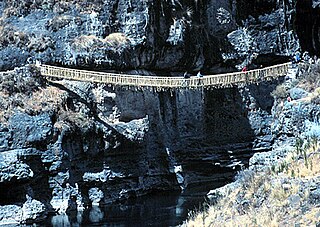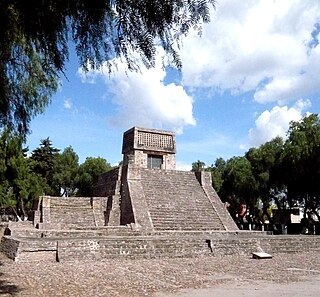Related Research Articles

Canals or artificial waterways are waterways or engineered channels built for drainage management or for conveyancing water transport vehicles. They carry free, calm surface flow under atmospheric pressure, and can be thought of as artificial rivers.

Tenochtitlan, also known as Mexico-Tenochtitlan, was a large Mexica altepetl in what is now the historic center of Mexico City. The exact date of the founding of the city is unclear. The date 13 March 1325 was chosen in 1925 to celebrate the 600th anniversary of the city. The city was built on an island in what was then Lake Texcoco in the Valley of Mexico. The city was the capital of the expanding Aztec Empire in the 15th century until it was captured by the Spanish in 1521.

Irrigation is the agricultural process of applying controlled amounts of water to land to assist in the production of crops, as well as to grow landscape plants and lawns, where it may be known as watering. Agriculture that does not use irrigation but instead relies only on direct rainfall is referred to as rain-fed. Irrigation has been a central feature of agriculture for over 5,000 years and has been developed independently by many cultures across the globe.

A qanat or kariz or foggaras, is a system for transporting water from an aquifer or water well to the surface, through an underground aqueduct. Constructed in Iran, Iraq and numerous other societies, this is an ancient system of water supply which allows water to be transported over long distances in hot dry climates without loss of much of the water to evaporation. The system has the advantage of being resistant to natural disasters such as earthquakes and floods, and to deliberate destruction in war. Furthermore, it is almost insensitive to the levels of precipitation, delivering a flow with only gradual variations from wet to dry years.

The Fall of Tenochtitlan, the capital of the Aztec Empire, was a decisive event in the Spanish conquest of the empire. It occurred in 1521 following extensive manipulation of local factions and exploitation of pre-existing political divisions by Spanish conquistador Hernán Cortés. He was aided by indigenous allies, and his interpreter and companion La Malinche.

The Valley of Mexico is a highlands plateau in central Mexico roughly coterminous with present-day Mexico City and the eastern half of the State of Mexico. Surrounded by mountains and volcanoes, the Valley of Mexico was a centre for several pre-Columbian civilizations, including Teotihuacan, the Toltec, and the Aztec. The ancient Aztec term Anahuac and the phrase Basin of Mexico are both used at times to refer to the Valley of Mexico. The Basin of Mexico became a well known site that epitomized the scene of early Classic Mesoamerican cultural development as well.

Aztec society was a highly complex and stratified society that developed among the Aztecs of central Mexico in the centuries prior to the Spanish conquest of Mexico, and which was built on the cultural foundations of the larger region of Mesoamerica. Politically, the society was organized into independent city-states, called altepetls, composed of smaller divisions (calpulli), which were again usually composed of one or more extended kinship groups. Socially, the society depended on a rather strict division between nobles and free commoners, both of which were themselves divided into elaborate hierarchies of social status, responsibilities, and power. Economically the society was dependent on agriculture, and also to a large extent on warfare. Other economically important factors were commerce, long-distance and local, and a high degree of trade specialization.

Maya architecture spans several thousands of years, several eras of political change, and architectural innovation before the Spanish colonization of the Americas. Often, the buildings most dramatic and easily recognizable as creations of the Maya peoples are the step pyramids of the Terminal Preclassic Maya period and beyond. Based in general Mesoamerican architectural traditions, the Maya utilized geometric proportions and intricate carving to build everything from simple houses to ornate temples. This article focuses on the more well-known pre-classic and classic examples of Maya architecture. The temples like the ones at Palenque, Tikal, and Uxmal represent a zenith of Maya art and architecture. Through the observation of numerous elements and stylistic distinctions, remnants of Maya architecture have become an important key to understanding their religious beliefs and culture as a whole.

Desert farming is the practice of developing agriculture in deserts. As agriculture depends upon irrigation and water supply, farming in arid regions where water is scarce is a challenge. However, desert farming has been practiced by humans for thousands of years. In the Negev Desert, there is evidence to suggest agriculture as far back as 5000 BC. Today, the Imperial Valley in southern California, Australia, Saudi Arabia, Israel and Palestine are examples of modern desert agriculture. Water efficiency has been important to the growth of desert agriculture. Water reuse, desalination, and drip irrigation are all modern ways that regions and countries have expanded their agriculture despite being in an arid climate.

The Zapotec civilization was an indigenous pre-Columbian civilization that flourished in the Valley of Oaxaca in Mesoamerica. Archaeological evidence shows that their culture originated at least 2,500 years ago. The Zapotec archaeological site at the ancient city of Monte Albán has monumental buildings, ball courts, magnificent tombs and grave goods, including finely worked gold jewelry. Monte Albán was one of the first major cities in Mesoamerica. It was the center of a Zapotec state that dominated much of the territory which today is known as the Mexican state of Oaxaca.

Incan engineers refers to several well trained civil engineers that built most of the structures and infrastructure in the renowned Incan empire.

Aztec architecture is a late form of Mesoamerican architecture developed by the Aztec civilization. Much of what is known about it comes from the structures that are still standing. These structures have survived for several centuries because of the strong materials used and the skill of the builders.

The pre-Columbian history of the territory now making up the country of Mexico is known through the work of archaeologists and epigraphers, and through the accounts of Spanish conquistadores, settlers and clergymen as well as the indigenous chroniclers of the immediate post-conquest period.

The Chapultepec aqueduct was built to provide potable water to Tenochtitlan, now known as Mexico City. This fresh water was transported from the Chapultepec springs. Two aqueducts following the same route from the springs were built by the Aztecs during the 15th century, the first destroyed by flooding and the second by the Spanish. After the Spanish conquest a colonial aqueduct was built, the ruins of which are located near Metro Sevilla.

Puquios are ancient systems of subterranean aqueducts which allow water to be transported over long distances in hot dry climates without loss of much of the water to evaporation. Puquios are found in the coastal deserts of southern Peru, especially in the Nazca region, and northern Chile. Forty-three puquios in the Nazca region were still in use in the early 21st century and relied upon to bring fresh water for irrigation and domestic use into desert settlements. The origin and dating of the Nazca puquios is disputed, although some archaeologists have estimated that their construction began about 500 CE by indigenous people of the Nazca culture.
Indigenous horticulture is practised in various ways across all inhabited continents. Indigenous refers to the native peoples of a given area and horticulture is the practice of small-scale intercropping.

The Preclassic period in Maya history stretches from the beginning of permanent village life c. 1000 BC until the advent of the Classic Period c. 250 AD, and is subdivided into Early, Middle, and Late. Major archaeological sites of this period include Nakbe, Uaxactun, Seibal, San Bartolo, Cival, and El Mirador.

An aqueduct is a watercourse constructed to carry water from a source to a distribution point far away. In modern engineering, the term aqueduct is used for any system of pipes, ditches, canals, tunnels, and other structures used for this purpose. The term aqueduct also often refers specifically to a bridge carrying an artificial watercourse. Aqueducts were used in ancient Greece, ancient Egypt, and ancient Rome. The simplest aqueducts are small ditches cut into the earth. Much larger channels may be used in modern aqueducts. Aqueducts sometimes run for some or all of their path through tunnels constructed underground. Modern aqueducts may also use pipelines. Historically, agricultural societies have constructed aqueducts to irrigate crops and supply large cities with drinking water.
References
- ↑ "The Pueblo Indians of North America", Holt, Rinehart, and Winston. 1970. New York.
- ↑ "The Great Temple of Tenochtitlan", Broda, Carrasco. 1988. Berkley.
- ↑ McKey, Doyle; Rostain, Stéphen; Iriarte, José; Glaser, Bruno; Birk, Jago Jonathan; Holst, Irene; Renard, Delphine (27 April 2010). "Pre-Columbian agricultural landscapes, ecosystem engineers, and self-organized patchiness in Amazonia". Proceedings of the National Academy of Sciences. 107 (17): 7823–7828. doi: 10.1073/pnas.0908925107 . PMC 2867901 . PMID 20385814.